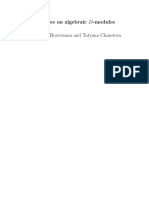0 ratings0% found this document useful (0 votes)
12 viewsFundamental Algorithms, Assignment 7
Fundamental Algorithms, Assignment 7
Uploaded by
Aashish DThis document provides instructions for Fundamental Algorithms Assignment 7 due on March 24/25. It includes 6 problems: 1) determining the longest common subsequence of two strings, 2) writing all parenthesizations of a string, 3) finding longest increasing/decreasing subsequences, 4) finding an optimal parenthesization of a matrix chain product, 5) exercises involving logarithms, and 6) two quotes about theories of the universe.
Copyright:
© All Rights Reserved
Available Formats
Download as PDF, TXT or read online from Scribd
Fundamental Algorithms, Assignment 7
Fundamental Algorithms, Assignment 7
Uploaded by
Aashish D0 ratings0% found this document useful (0 votes)
12 views2 pagesThis document provides instructions for Fundamental Algorithms Assignment 7 due on March 24/25. It includes 6 problems: 1) determining the longest common subsequence of two strings, 2) writing all parenthesizations of a string, 3) finding longest increasing/decreasing subsequences, 4) finding an optimal parenthesization of a matrix chain product, 5) exercises involving logarithms, and 6) two quotes about theories of the universe.
Original Title
hw7.pdf
Copyright
© © All Rights Reserved
Available Formats
PDF, TXT or read online from Scribd
Share this document
Did you find this document useful?
Is this content inappropriate?
This document provides instructions for Fundamental Algorithms Assignment 7 due on March 24/25. It includes 6 problems: 1) determining the longest common subsequence of two strings, 2) writing all parenthesizations of a string, 3) finding longest increasing/decreasing subsequences, 4) finding an optimal parenthesization of a matrix chain product, 5) exercises involving logarithms, and 6) two quotes about theories of the universe.
Copyright:
© All Rights Reserved
Available Formats
Download as PDF, TXT or read online from Scribd
Download as pdf or txt
0 ratings0% found this document useful (0 votes)
12 views2 pagesFundamental Algorithms, Assignment 7
Fundamental Algorithms, Assignment 7
Uploaded by
Aashish DThis document provides instructions for Fundamental Algorithms Assignment 7 due on March 24/25. It includes 6 problems: 1) determining the longest common subsequence of two strings, 2) writing all parenthesizations of a string, 3) finding longest increasing/decreasing subsequences, 4) finding an optimal parenthesization of a matrix chain product, 5) exercises involving logarithms, and 6) two quotes about theories of the universe.
Copyright:
© All Rights Reserved
Available Formats
Download as PDF, TXT or read online from Scribd
Download as pdf or txt
You are on page 1of 2
Fundamental Algorithms, Assignment 7
Due March 24/25 in Recitation.
What you need is that your brain is open. Paul Erdos
1. Determine an LCS of 10010101 and 010110110 using the algorithm
studied.
2. Write all the parenthesizations of ABCDE. Associate them in a nat-
ural way with (setting n = 5) the terms P (i)P (n i), i = 1, 2, 3, 4
given in the recursion for P (n).
3. Let x1 , . . . , xm be a sequence of distinct real numbers. For 1 i m
let IN C[i] denote the length of the longest increasing subsequence
ending with xi . Let DEC[i] denote the length of the longest decreasing
subsequence ending with xi . Caution: The subsequence must use xi .
For example, 20, 30, 4, 50, 10. Now IN C[5] = 2 because of 4, 10 we
do not count 20, 30, 50.
(a) Find an efficient method for finding the values IN C[i], 1 i n.
(You should find IN C[i] based on the previously found IN C[j],
1 j < i. Your algorithm should take time O(i) for each partic-
ular i and thus O(n2 ) overall.)
(b) Let LIS denote the length of the longest increasing subsequence
of x1 , . . . , xm . Show how to find LIS from the values IN C[i].
Your algorithm, starting with the IN C[i], should take time O(n).
Similarly, let DIS denote the length of the longest decreasing
subsequence of x1 , . . . , xm . Show how to find DIS from the values
DEC[i].
(c) Suppose i < j. Prove that it is impossible to have IN C[i] =
IN C[j] and DEC[i] = DEC[j]. (Hint: Show that if xi < xj
then IN C[j] IN C[i] + 1.)
(d) Deduce the following celebrated result (called the Monotone Sub-
sequence Theorem) of Paul Erdos and George Szekeres: Let m =
ab + 1. Then any sequence x1 , . . . , xm of distinct real numbers
either LIS > a or DIS > b. (Idea: Assume not and look at
the pairs (IN C[i], DEC[i]).) Paul Erdos was a great twentieth
century mathematician, whose work remains highly influential in
many areas.
4. Find an optimal parenthesization of a matrix-chain product whose
sequence of dimensions is 5, 10, 3, 12, 5, 50, 6.
5. Some exercises in logarithms:
(a) Write lg(4n / n) in simplest form. What is its asymptotic value.
(b) Which is bigger, 5313340 or 7271251 ? Give reason. (You can use a
calculator but you cant use any numbers bigger than 109 .)
(c) Simplify n2 lg(n2 ) and lg2 (n3 ).
2 /2
(d) Solve (for x) the equation ex = n1 .
(e) Write logn 2n and logn n2 in simple form.
(f) What is the relationship between lg n and log3 n?
(g) Assume i < n. How many times need i be doubled before it
reaches (or exceeds) n?
(h) Write lg[nn en 2n] precisely as a sum in simplest form. What
is it asymptotic to as n ? What is interesting about the
bracketed expression?
There is a theory which states that if ever anybody discovers ex-
actly what the Universe is for and why it is here, it will instantly
disappear and be replaced by something even more bizarre and
inexplicable. There is another theory which states that this has
already happened.
Douglas Adams
You might also like
- Problem Set 1Document13 pagesProblem Set 1redNo ratings yet
- MTH3020Document21 pagesMTH3020pHysiXNo ratings yet
- Dicktator Genitalia 0.3 For G8M: Mini-TutorialDocument4 pagesDicktator Genitalia 0.3 For G8M: Mini-TutorialAurora100% (1)
- 10 2514@4 868894Document181 pages10 2514@4 868894amerNo ratings yet
- Naive Ba YesDocument5 pagesNaive Ba Yeslubna_java2858No ratings yet
- 1964 24erdosDocument14 pages1964 24erdosvahidmesic45No ratings yet
- 1957 13erdosDocument10 pages1957 13erdosvahidmesic45No ratings yet
- MATS 4217 Tutorial 1Document4 pagesMATS 4217 Tutorial 1nchangdania05No ratings yet
- 1970 23erdosDocument3 pages1970 23erdosvahidmesic45No ratings yet
- 1 ProjectDocument4 pages1 Projectjanecoco0222No ratings yet
- Lec05 PrimeDistributionDocument4 pagesLec05 PrimeDistributionJames MlotshwaNo ratings yet
- 1982 34erdosDocument4 pages1982 34erdosvahidmesic45No ratings yet
- Mid2 2022 November SolutionDocument11 pagesMid2 2022 November SolutionSameer UddinNo ratings yet
- CV 201008 Complex Analysis Qualifier Exam, August 2010Document3 pagesCV 201008 Complex Analysis Qualifier Exam, August 2010Christopher BreedenNo ratings yet
- Integral m103 - Notes - 04Document49 pagesIntegral m103 - Notes - 04MANAYE MAJORANo ratings yet
- 2020 Papers StattisticsDocument9 pages2020 Papers Stattisticsmadhurkhandelwal98712No ratings yet
- 1964 20erdosDocument11 pages1964 20erdosvahidmesic45No ratings yet
- 1978 26erdosDocument7 pages1978 26erdosvahid mesicNo ratings yet
- 1985 16erdosDocument14 pages1985 16erdosvahidmesic45No ratings yet
- Mid2 SOLUTIONDocument11 pagesMid2 SOLUTIONFarrukh AbbasNo ratings yet
- Birla Institute of Technology and Science, PilaniDocument1 pageBirla Institute of Technology and Science, PilaniUtkarsh GuptaNo ratings yet
- AD I Practice QuestionsDocument11 pagesAD I Practice QuestionsV KumarNo ratings yet
- Mathematics: Ans. CompleteDocument53 pagesMathematics: Ans. CompleteKassandra Kay MislangNo ratings yet
- The Average Smarandache FunctionDocument9 pagesThe Average Smarandache FunctionMia AmaliaNo ratings yet
- 1985 19erdosDocument18 pages1985 19erdosvahidmesic45No ratings yet
- A SAT Attack On The Erd Os Discrepancy Conjecture: N D 2d 3d KD K I 1 IdDocument8 pagesA SAT Attack On The Erd Os Discrepancy Conjecture: N D 2d 3d KD K I 1 IdAdi ParamarthaNo ratings yet
- Trigonometry and Complex Numbers: Jubayer Rahman Nirjhor Class 10, Annada Govt. High School, BangladeshDocument5 pagesTrigonometry and Complex Numbers: Jubayer Rahman Nirjhor Class 10, Annada Govt. High School, BangladeshJubayer Rahman NirjhorNo ratings yet
- EE5130: Digital Signal ProcessingDocument3 pagesEE5130: Digital Signal ProcessingSHUBHAM ANAND VERMA EE20M540No ratings yet
- A SAT Attack On The Erd Os Discrepancy ConjectureDocument8 pagesA SAT Attack On The Erd Os Discrepancy ConjecturehongnhNo ratings yet
- Informatik: Universit at Des SaarlandesDocument2 pagesInformatik: Universit at Des SaarlandesvenugopalNo ratings yet
- HW 1Document2 pagesHW 1smitha_gururajNo ratings yet
- Jaroslav Hancl, Pavel Rucki - Increase Your Mathematical Intelligence-Ostrava University, Faculty of Science (2007)Document87 pagesJaroslav Hancl, Pavel Rucki - Increase Your Mathematical Intelligence-Ostrava University, Faculty of Science (2007)qawsedNo ratings yet
- Csci2100a Estr2102 HWDocument135 pagesCsci2100a Estr2102 HWAsdasd SdasNo ratings yet
- Tutorial 1Document3 pagesTutorial 1Ashish KatochNo ratings yet
- 1 Pu Maths MODEL QP - 2Document3 pages1 Pu Maths MODEL QP - 2tejaswinicariappaNo ratings yet
- Metric and Topological SpacesDocument109 pagesMetric and Topological SpacesAnton Perkov100% (1)
- HW 4Document2 pagesHW 4ashish3586No ratings yet
- Prob Lem Sheet 1Document2 pagesProb Lem Sheet 1Lewis EvansNo ratings yet
- GifDocument16 pagesGifAbhishek SinghNo ratings yet
- NOTES 10.3 Epsilon-Delta ProofsDocument4 pagesNOTES 10.3 Epsilon-Delta ProofsMarina XuNo ratings yet
- MSC Mas6002, Introductory Material Block C Mathematical Methods ExercisesDocument11 pagesMSC Mas6002, Introductory Material Block C Mathematical Methods ExercisesCourtney WilliamsNo ratings yet
- MA4254 Discrete OptimizationDocument69 pagesMA4254 Discrete OptimizationmengsiongNo ratings yet
- FundamentalDocument156 pagesFundamentalZEPPI22No ratings yet
- (Lecture Notes) Alexander Braverman and Tatyana Chmutova - Lectures On Algebraic D-Modules (-)Document79 pages(Lecture Notes) Alexander Braverman and Tatyana Chmutova - Lectures On Algebraic D-Modules (-)QweNo ratings yet
- Dynamic Programming:: Example 1: Assembly Line Scheduling. InstanceDocument14 pagesDynamic Programming:: Example 1: Assembly Line Scheduling. Instancekaustubh2008satputeNo ratings yet
- Fundamental Algorithms Final ExamDocument3 pagesFundamental Algorithms Final ExamAashish DNo ratings yet
- Oxbridge Interview QuestionsDocument5 pagesOxbridge Interview Questionsfacts.agency45No ratings yet
- Data Structures - Assignment 4 IDC, Spring 2022Document3 pagesData Structures - Assignment 4 IDC, Spring 2022eleanorNo ratings yet
- HW 2Document3 pagesHW 2Balakrishna KolliNo ratings yet
- Metric and Topological Spaces: T. W. K Orner February 19, 2016Document109 pagesMetric and Topological Spaces: T. W. K Orner February 19, 2016TamathNo ratings yet
- Kovic 4Document16 pagesKovic 4Francis BurerosNo ratings yet
- Number - Theory 23 1Document2 pagesNumber - Theory 23 1emmanuelaudige7No ratings yet
- 2021SEM2 CS3230 SolsDocument10 pages2021SEM2 CS3230 SolsNancy QNo ratings yet
- Dethi GTHDocument1 pageDethi GTHapi-27337837No ratings yet
- MATS 4217 Tutorial 4Document3 pagesMATS 4217 Tutorial 4nchangdania05No ratings yet
- ISI MStat PSB Past Year Paper 2014Document6 pagesISI MStat PSB Past Year Paper 2014Vinay Kumar ChennojuNo ratings yet
- S S S 1fur Maths 2nd Term E-Note 2017Document64 pagesS S S 1fur Maths 2nd Term E-Note 2017praiseforever90100% (1)
- MATS 4217 Tutorial 5Document5 pagesMATS 4217 Tutorial 5nchangdania05No ratings yet
- Assignment 3Document1 pageAssignment 3Vishesh KumarNo ratings yet
- Keo Sodara - High School Math Contest IIDocument528 pagesKeo Sodara - High School Math Contest IIFelipe GallegosNo ratings yet
- MAD101 Assignment 2Document2 pagesMAD101 Assignment 2Phúc HồngNo ratings yet
- Fundamental MathsDocument165 pagesFundamental MathszuhairNo ratings yet
- Fundamental Algorithms, Assignment 13Document2 pagesFundamental Algorithms, Assignment 13Aashish DNo ratings yet
- Fundamental Algorithms Midterm SolutionsDocument3 pagesFundamental Algorithms Midterm SolutionsAashish DNo ratings yet
- Fundamental Algorithms, Assignment 5 SolutionsDocument3 pagesFundamental Algorithms, Assignment 5 SolutionsAashish DNo ratings yet
- Fundamental Algorithms, Assignment 11Document4 pagesFundamental Algorithms, Assignment 11Aashish DNo ratings yet
- Fundamental Algorithms, Assignment 6 SolutionsDocument3 pagesFundamental Algorithms, Assignment 6 SolutionsAashish DNo ratings yet
- Fundamental Algorithms, Assignment ωDocument3 pagesFundamental Algorithms, Assignment ωAashish DNo ratings yet
- Fundamental Algorithms, Assignment 12Document4 pagesFundamental Algorithms, Assignment 12Aashish DNo ratings yet
- Fundamental Algorithms, Assignment 7 SolutionsDocument6 pagesFundamental Algorithms, Assignment 7 SolutionsAashish DNo ratings yet
- Fundamental Algorithms, Assignment 4 SolutionsDocument3 pagesFundamental Algorithms, Assignment 4 SolutionsAashish DNo ratings yet
- hw9 PDFDocument3 pageshw9 PDFAashish DNo ratings yet
- Fundamental Algorithms, Assignment 13Document1 pageFundamental Algorithms, Assignment 13Aashish DNo ratings yet
- Fundamental Algorithms, Assignment 10 SolutionsDocument2 pagesFundamental Algorithms, Assignment 10 SolutionsAashish DNo ratings yet
- Midterm PDFDocument2 pagesMidterm PDFAashish DNo ratings yet
- Fundamental Algorithms, Assignment 10Document2 pagesFundamental Algorithms, Assignment 10Aashish DNo ratings yet
- Fundamental Algorithms, Problem Set 1 SolutionsDocument3 pagesFundamental Algorithms, Problem Set 1 SolutionsAashish DNo ratings yet
- Fundamental Algorithms, Assignment 9 SolutionsDocument5 pagesFundamental Algorithms, Assignment 9 SolutionsAashish DNo ratings yet
- Fundamental Algorithms, Assignment 8Document3 pagesFundamental Algorithms, Assignment 8Aashish DNo ratings yet
- Fundamental Algorithms, Problem Set 2 SolutionsDocument4 pagesFundamental Algorithms, Problem Set 2 SolutionsAashish DNo ratings yet
- Fundamental Algorithms, Problem Set 3 SolutionsDocument5 pagesFundamental Algorithms, Problem Set 3 SolutionsAashish DNo ratings yet
- Fundamental Algorithms, Problem Set 2: Former Student, Now Big Cheese at GE HyderabadDocument1 pageFundamental Algorithms, Problem Set 2: Former Student, Now Big Cheese at GE HyderabadAashish DNo ratings yet
- Fundamental Algorithms, Assignment 11Document2 pagesFundamental Algorithms, Assignment 11Aashish DNo ratings yet
- Fundamental Algorithms Final ExamDocument3 pagesFundamental Algorithms Final ExamAashish DNo ratings yet
- Fundamental Algorithms, Assignment 7 Due March 9/10 in RecitationDocument2 pagesFundamental Algorithms, Assignment 7 Due March 9/10 in RecitationAashish DNo ratings yet
- Fundamental Algorithms, Assignment 4: A B A BDocument2 pagesFundamental Algorithms, Assignment 4: A B A BAashish DNo ratings yet
- hw5 PDFDocument2 pageshw5 PDFAashish DNo ratings yet
- hw8 PDFDocument2 pageshw8 PDFAashish DNo ratings yet
- Fundamental Algorithms, Problem Set 1 Not To Be SubmittedDocument1 pageFundamental Algorithms, Problem Set 1 Not To Be SubmittedAashish DNo ratings yet
- Fundamental Algorithms Final ExamDocument2 pagesFundamental Algorithms Final ExamAashish DNo ratings yet
- Fundamental Algorithms, Problem Set 3Document2 pagesFundamental Algorithms, Problem Set 3Aashish DNo ratings yet
- Investigatory ProjectDocument8 pagesInvestigatory ProjectAiren LianNo ratings yet
- Arrester I235-94Document12 pagesArrester I235-94tableman.test9000No ratings yet
- Carmichael 1957Document12 pagesCarmichael 1957Anhar AnharNo ratings yet
- Maintenance and Safety Manual For I-Series Machines v388ENDocument126 pagesMaintenance and Safety Manual For I-Series Machines v388ENzotya54No ratings yet
- Gravity Dams Fluids 1 PDFDocument27 pagesGravity Dams Fluids 1 PDFChristian DayritNo ratings yet
- Invitation Letter PQT AEC & CWCDocument3 pagesInvitation Letter PQT AEC & CWCIqbal Nurrasa BaktiNo ratings yet
- Obituary-Dr. Jugal Kishore 4Document3 pagesObituary-Dr. Jugal Kishore 4Rajender WahiNo ratings yet
- 5 - Pair R. V.Document24 pages5 - Pair R. V.abd syNo ratings yet
- Sowing Into The AnointingDocument9 pagesSowing Into The AnointingKoutosuisse100% (1)
- 1.timing Optimization Techniques: 1. MappingDocument152 pages1.timing Optimization Techniques: 1. MappingPraveen Kumar100% (1)
- 2019 Traxxas Parts Catalog 9th Ed Vol 2Document157 pages2019 Traxxas Parts Catalog 9th Ed Vol 2oswaldo venegasNo ratings yet
- Un Symmetrical Bending and Shear CentreDocument11 pagesUn Symmetrical Bending and Shear CentreanilNo ratings yet
- GEN PHYSICS 1 2nd QT ExamDocument5 pagesGEN PHYSICS 1 2nd QT ExamAriane DionisioNo ratings yet
- Science: Organic Compounds and Functional GroupsDocument38 pagesScience: Organic Compounds and Functional GroupsEunice AnogNo ratings yet
- Community Nutrition Position Paper - Should Foods Include A Mandatory Gmo LabelDocument3 pagesCommunity Nutrition Position Paper - Should Foods Include A Mandatory Gmo Labelapi-347957158No ratings yet
- Experiment 3Document3 pagesExperiment 3dummy008No ratings yet
- Circuit Theory I - LecDocument137 pagesCircuit Theory I - LecAsaad MusaabNo ratings yet
- 1-8 Practice - BDocument2 pages1-8 Practice - BStanleyNo ratings yet
- Alternative Medicine in BelizeDocument5 pagesAlternative Medicine in BelizeMyaW731No ratings yet
- Beta 3 B118a Sigma Active Subwoofer Speaker SystemDocument4 pagesBeta 3 B118a Sigma Active Subwoofer Speaker SystemGabriel0% (1)
- Onshape College Lesson 10Document43 pagesOnshape College Lesson 10tottoNo ratings yet
- Vibrating Wire Load CellDocument4 pagesVibrating Wire Load Cells pradhanNo ratings yet
- UNSPSC Business Category and Family CodesDocument13 pagesUNSPSC Business Category and Family CodesvipinchawlaNo ratings yet
- Usa Amc - 12 Ahsme 2013Document10 pagesUsa Amc - 12 Ahsme 2013Wang WilliamNo ratings yet
- Inmarsat Vocality Radio Over IPDocument8 pagesInmarsat Vocality Radio Over IPJorge CasaliNo ratings yet
- Crompton Blue Chip Case Study.Document11 pagesCrompton Blue Chip Case Study.KinjalBhadreshwara0% (2)
- Non Peza ClientsDocument15 pagesNon Peza ClientsDioscoro J. Jebulan100% (1)





















































































































